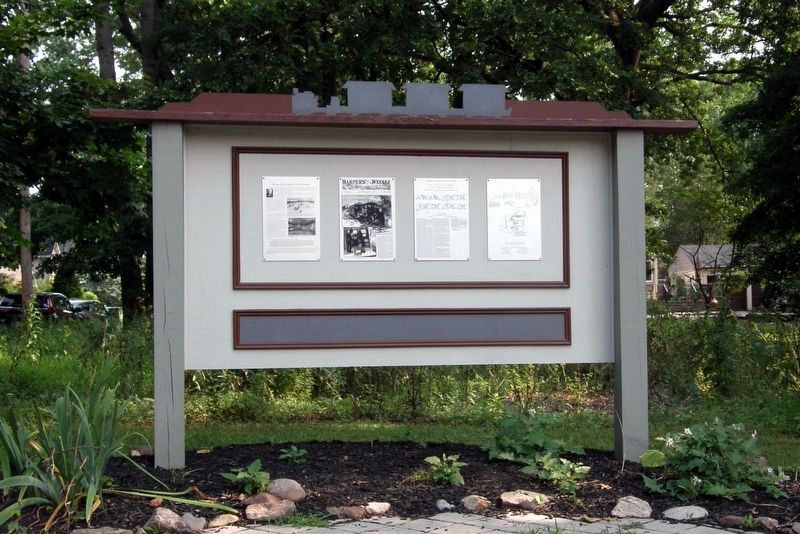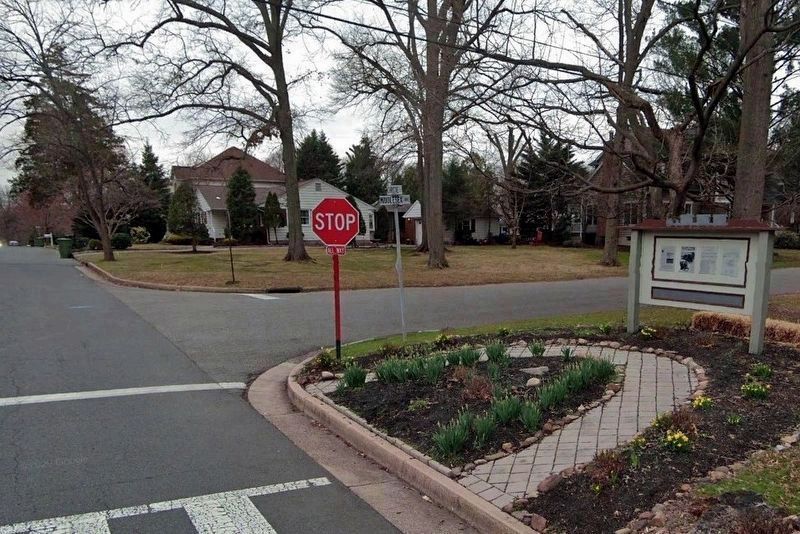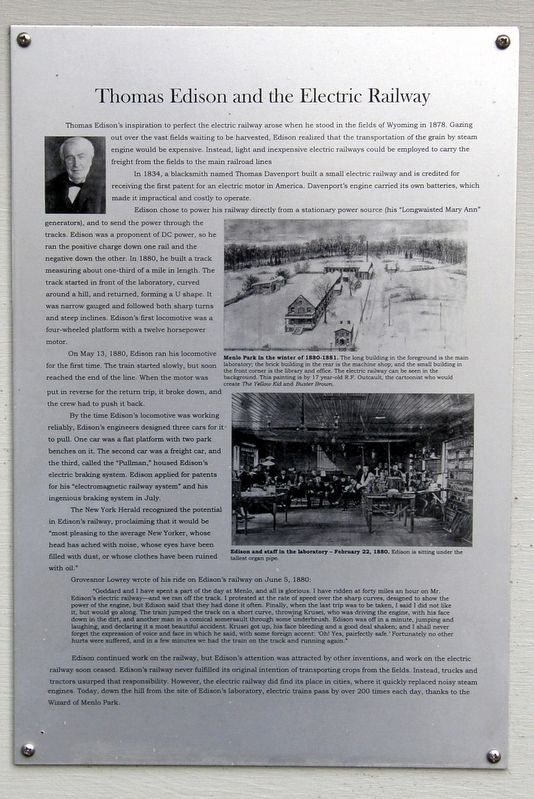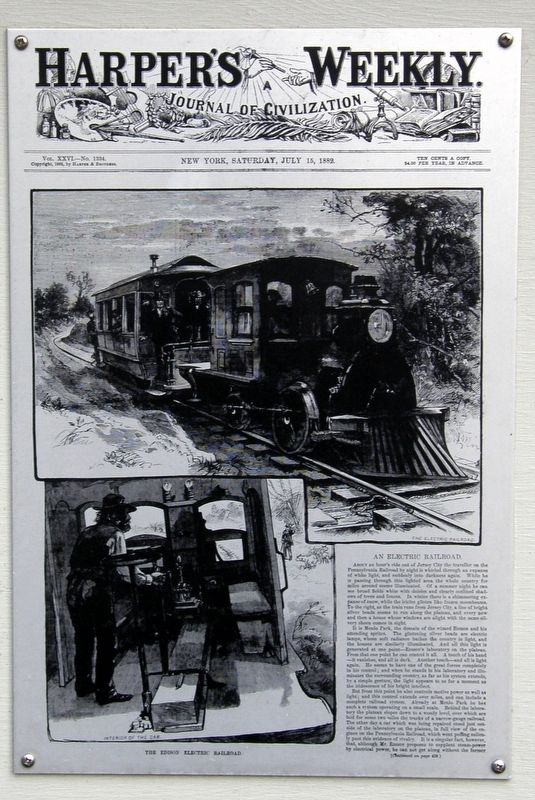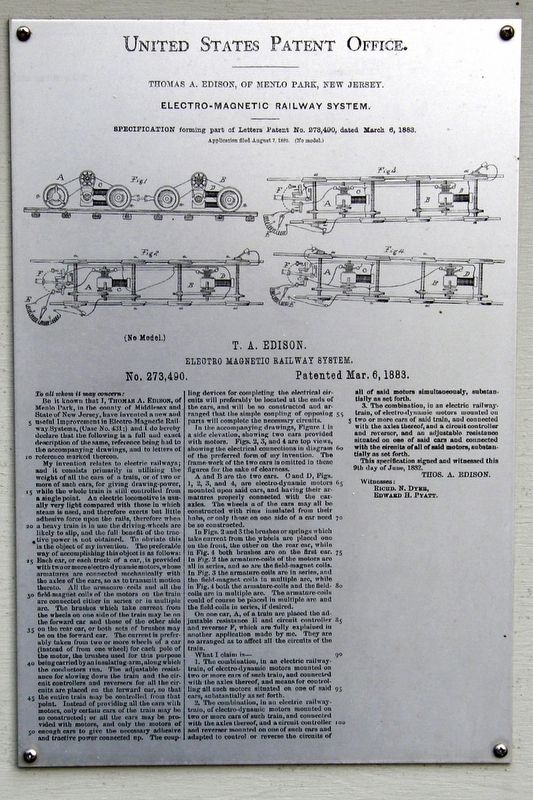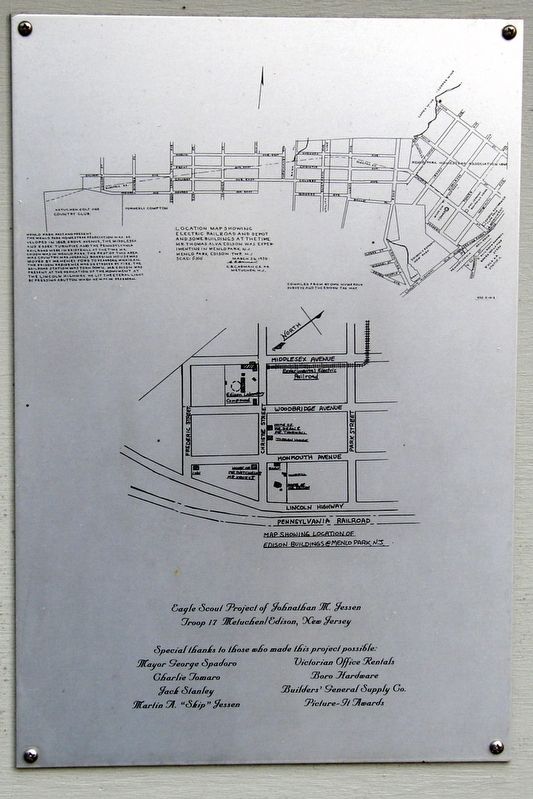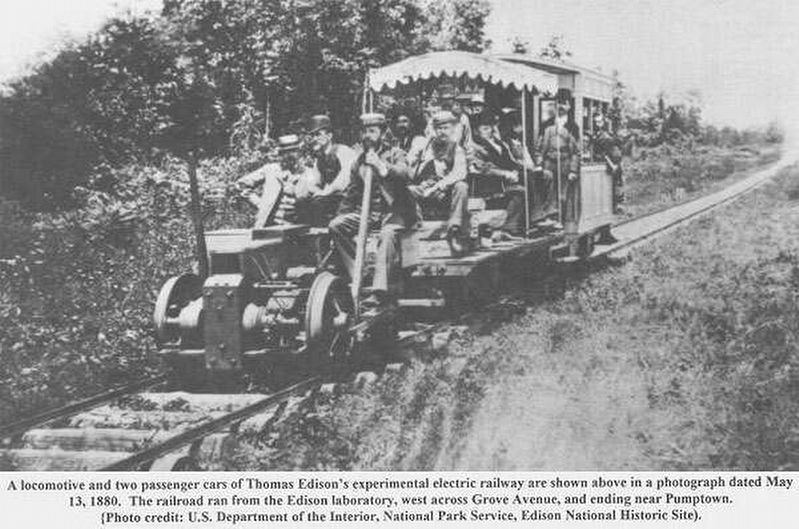Menlo Park in Middlesex County, New Jersey — The American Northeast (Mid-Atlantic)
Thomas Edison and the Electric Railway
Thomas Edisonís inspiration to perfect the electric railway arose when he stood in the fields of Wyoming in 1878. Gazing out over the vast fields waiting to be harvested, Edison realized that the transportation of the grain by steam engine would be expensive. Instead, light and inexpensive electric railways could be employed to carry the freight from the fields to the main railway lines (sic)
In 1834, a blacksmith named Thomas Davenport built a small electric railway and is credited for receiving the first patent for an electric motor in America. Davenportís engine carried its own batteries, which made it impractical and costly to operate.
Edison chose to power his railway directly from a stationary power source (his “Longwaisted Mary Ann” generators), and to send power through the tracks. Edison was a proponent of DC power, so he ran a positive charge down one rail and a negative down the other. In 1880, he built a track measuring one-third of a mile in length. The track started in front of the laboratory, curved around a hill, and returned, following a U shape. It was narrow gauged and followed both sharp turns and steep inclines. Edisonís first locomotive was a four-wheel platform with a twelve horsepower motor.
On May 13, 1880, Edison ran his locomotive for the first time. The train started slowly, but soon reached then end of the line. When the motor was put in reverse for the return trip, it broke down and the crew had to push it back.
By the time Edisonís locomotive was working reliably, Edisonís engineers designed three cars for it to pull. One car was a flat platform with two park benches on it. The second car was a freight car, and the third, called the “Pullman,” housed Edisonís electric braking system. Edison applied for patents for his “electromagnetic railway system” and his ingenious braking system in July.
The New York Herald recognized the potential of Edisonís railway, proclaiming that it would be “most pleasing to the average New Yorker, whose head has ached with noise, whose eyes have been filled with dust, or whose clothes have been ruined with oil.”
Grosvenor Lowrey wrote of his ride on Edisonís railway on June 5, 1880:
“Goddard and I have spent a part of the day at Menlo, and all is glorious. I have ridden at forty miles an hour on Mr. Edisonís electric railway – and we ran off the track. I protested at the rate of speed over the sharp curves, designed to show the power of the engine, but Edison dais they had done it often. Finally, when the last trip was to be taken, I said I did not like it, but would go along. The train jumped the track on a short curve, throwing Krusei,
who was driving the engine, with his face down in the dirt, and another man in a comical somersault through some underbrush. Edison was off in a minute, jumping and laughing, and declaring it a moist beautiful accident. Krusei got up, his face bleeding and a good deal shaken; and I shall never forget the expression of voice and face in which he said, with some foreign accent: “Oh! Yes, pairfectly safe.í Fortunately no other hurts were suffered, and in a few minutes we had the train on the track and running again.”
Edison continued work on the railway, but Edisonís attention was attracted by other inventions, and work on the electric railway soon ceased. Edisonís railway never fulfilled its original intention of transporting crops from the fields. Instead, trucks and tractors usurped that responsibility. However, the electric railway did find its place in cities, where it quickly replaced noisy steam engines. Today, down the hill from the site of Edisonís laboratory, electric trains pass by over 200 times each day, thanks to the Wizard of Menlo Park.
Eagle Project of Johnathan M. Jessen
Troop 17 Metuchen/Edison, New Jersey
Erected by Johnathan M. Jessen,Troop 17 Metuchen/Edison, New Jersey.
Topics. This historical marker is listed in this topic list: Railroads & Streetcars. A significant historical date for this entry is May 13, 1880.
Location.
40° 33.826′ N, 74° 20.346′ W. Marker is in Menlo Park, New Jersey, in Middlesex County. Marker is at the intersection of Christie Street and Middlesex Avenue, on the right when traveling west on Christie Street. Touch for map. Marker is at or near this postal address: 37 Christie Street, Edison NJ 08837, United States of America. Touch for directions.
Other nearby markers. At least 8 other markers are within one mile of this marker, measured as the crow flies. Thomas Alva Edison Memorial Tower (within shouting distance of this marker); Thomas Edisonís Office 1879 to 1884 (within shouting distance of this marker); Thomas Alva Edisonís Menlo Park Invention Factory (about 300 feet away, measured in a direct line); The Invention of the Phonograph (about 300 feet away); Sarah B. Jordan Boarding House (about 300 feet away); Thomas Alva Edison Menlo Park Memorial (approx. 0.2 miles away); Menlo Park Terrace (approx. one mile away); First Presbyterian Church Of Iselin (approx. 1.1 miles away). Touch for a list and map of all markers in Menlo Park.
Also see . . . Edison and the electric railroad. "Hidden New Jersey" entry (Submitted on December 11, 2020, by Larry Gertner of New York, New York.)
Credits. This page was last revised on December 11, 2020. It was originally submitted on December 11, 2020, by Larry Gertner of New York, New York. This page has been viewed 850 times since then and 83 times this year. Photos: 1, 2, 3, 4, 5, 6, 7. submitted on December 11, 2020, by Larry Gertner of New York, New York.
